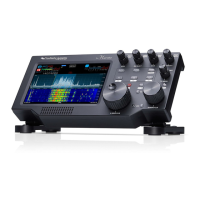FLEX-6000 Signature Series – Maestro User Guide
Page 80
Copyright 2019 FlexRadio Systems. All Rights Reserved.
• Press MOX or press a PTT to enable the transmitter.
• Tap the RECORD icon (red dot) on the control panel. It will flash when recording.
• Talk normally into the microphone.
• When done, tap the RECORD icon to stop recording.
• Tap the PLAY icon to play back the transmitted audio.
See section 9.7, Recording and Playback of Slice Receiver Audio for complete details on the usage
of this feature.
17.6 RECOMMENDED AUDIO ADJUSTMENT STEPS FOR PHONE MODES
Use of a second receiver to monitor your transmitted audio in real time is the preferred method for
making the adjustments listed below. Otherwise, use the Quick Record and Playback procedure
described above for monitoring your transmitted audio and making the following adjustments.
• Select the desired microphone input from the list in the TX Menu.
• Select the desired transmit filter width on the TX Menu.
• Turn the speech processor off by pressing the PROC button in the TX Menu so that it is not
highlighted.
• Adjust the TX Equalizer to compensate for the microphone and operating conditions. The
default setting is a good starting point for most microphones. The TX EQ is located after the
processor in the signal chain, so it should typically be adjusted prior to engaging the
processor. Minor adjustments can be done after engaging the processor, but care is needed
to avoid excessive peaks.
• Speak into the microphone at the loudest voice level you would normally use.
• Adjust the microphone gain control so that the peak indicator hovers near 0 VU on the Level
meter. Most microphones will require the +20 dB gain preamp to be enabled on the
Phone/CW tab of the Main Menu.
• Turn on the speech processor with the PROC button. The adjacent slider sets the
Compression setting. In most cases use the NORM (normal) setting. Selecting DX and DX+
adds additional compression without distorting the audio.
• Readjust the transmit equalizer to optimize the audio for your voice characteristics, the
desired operating style and microphone response once PROC is enabled.
• Enable the DEXP, setting it for your operating position’s ambient background noise. Ideally
any device that generates background noise should be on so that the DEXP is optimally
configured.
• If VOX operation is desired, enable the VOX button and adjust VOX gain/delay for proper
operation.
The settings described above are included in MIC profiles. After the controls are adjusted, their
settings can be saved for future use by storing a MIC profile. See section 14.1, MIC Profiles.

